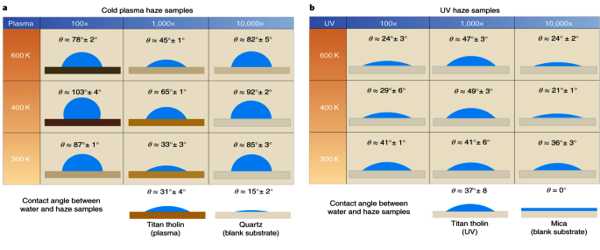Many exoplanets have opaque atmospheres that are obscured by clouds or hazes, making it difficult for astronomers to determine their chemical compositions. According to a new study, haze particles produced under various conditions have a variety of properties that can determine how clear or hazy a planet’s atmosphere is likely to be.
Small organic haze particles are formed as a result of photochemical reactions in the atmospheres of temperate exoplanets. Every day, large amounts of these photochemical hazes form in the Earth’s atmosphere, despite the fact that our planet has relatively clear skies. The reason for this is due to the ease with which haze particles are removed from the atmosphere by deposition processes.
“How clear the atmosphere is determined not only by haze production but also by haze removal,” said Xinting Yu, a postdoctoral fellow at UC Santa Cruz and lead author of the study, which was published in Nature Astronomy.
A new study shows that haze particles produced under different conditions have a wide range of properties that can determine how clear or hazy a planet’s atmosphere is likely to be.
Yu and her colleagues studied the properties of haze particles created in the lab under conditions resembling exoplanet atmospheres, including a variety of gas compositions, temperatures, and energy sources. Laboratory experiments like this, according to coauthor Xi Zhang, assistant professor of Earth and planetary sciences at UC Santa Cruz, are critical for understanding haze formation and its impact on observations.
“Because we can’t bring back haze samples from exoplanets, we have to try to mimic atmospheric conditions in the laboratory,” she explained. According to Yu, the removal of haze is dependent on a critical material property of the particles known as surface energy. “Surface energy describes how cohesive or ‘sticky’ a material is,” she explains.
When sticky haze particles collide, they easily bond with one another, growing into larger particles that fall out of the atmosphere onto the planet’s surface (a process called a dry deposition). They also serve as excellent condensation nuclei for cloud droplets and are easily removed by wet deposition. Because hazes produced on Earth have high surface energy, they are ‘sticky’ and efficiently removed from the atmosphere.

Yu’s laboratory experiments show that the hazes produced in exoplanet atmospheres have a wide range of properties that vary depending on the conditions under which they are produced. “Some of them are similar to Earth haze in that they have high surface energy and are easy to remove, resulting in clear skies,” she explained. “However, some of them, like a nonstick pan, have very low surface energy; they do not bond with other particles very well and remain as small particles hanging in the atmosphere for a long time.”
The temperature at which the haze particles are formed was discovered to be a critical factor in the study. Hazes produced around 400 Kelvin (260°F) had the lowest surface energies, resulting in less efficient removal and hazier atmospheres. This discovery is consistent with observed trends, according to Yu, who notes that exoplanets with temperatures ranging from 400 to 500 K are the haziest.
Cooler planets in their host stars’ habitable zones are more likely to have clear atmospheres, she says. “We may not have to worry about habitable exoplanets being too hazy for future observations,” Yu said, explaining that hazes have higher surface energies at lower temperatures. “As a result, these hazes are easily removed, leaving relatively clear atmospheres.”
The upcoming James Webb Space Telescope will provide astronomers with a powerful tool for characterizing exoplanet atmospheres (JWST). When an exoplanet transits across the face of its star, its atmosphere filters the star’s light, allowing astronomers with sensitive enough telescopes (such as JWST) to identify the chemical components of the atmosphere using transmission spectroscopy.
A hazy atmosphere would interfere with transmission spectroscopy, but the hazes themselves, according to Zhang, could still yield valuable information.
“Hazes don’t have no features,” he explained. “We may be able to characterize the composition of exoplanet hazes and understand their chemistry with better telescopes. However, without data from laboratory experiments, the observations will be difficult to explain. This research has revealed the enormous variety of haze particles, and understanding their optical properties will be a top priority for future research.”














